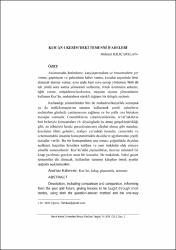| dc.contributor.author | Kılıçarslan, Mehmet | |
| dc.date.accessioned | 2018-07-19T11:10:43Z | |
| dc.date.available | 2018-07-19T11:10:43Z | |
| dc.date.issued | 2016 | |
| dc.identifier.uri | https://hdl.handle.net/20.500.11776/2812 | |
| dc.description.abstract | Anlatımında, betimleme, karşılaştırmalara ve benzetmelere yer verme, geçmişten ve gelecekten haber verme, kıssalar sayesinde ibret alınacak dersler verme, aynı anda hem soru-cevap yöntemini hem de tek yönlü soru sorma yöntemini kullanma, örnek üzerinden anlatım, öğüt verme, müjdeleme-korkutma, meydan okuma yöntemlerini kullanan Kur’ân, muhatabına sürekli değişen bir üslupla seslenir. Kullandığı yöntemlerden biri de muhadese/karşılıklı konuşma ya da intâk/konuşturma sanatını kullanarak çeşitli sahnelerin muhatabın gözünde canlanmasını sağlama ve bu yolla ona birtakım mesajlar vermedir. Cennetliklerin, cehennemliklerin, A‘raf’takilerin biri birleriyle konuşmaları vb. diyaloglarla bu amaç gerçekleştirildiği gibi, an itibariyle henüz gerçekleşmemiş olaylar olmuş gibi sunulup, kendisine ölüm gelenler, mahşer yerindeki insanlar, cennetteki ve cehennemdeki insanlar konuşturulmakla da onların ağızlarından çeşitli mesajlar verilir. Bu tür konuşmaların ana teması çoğunlukla duyulan nedâmet, kaçırılan fırsatlara üzülme ve yeni imkânlar elde etmeye yönelik temennilerdir. Kur’ân’daki pişmanlıklar, üzerine müstakil bir kitap yazılması gereken uzun bir konudur. Bu makalede, bahsi geçen temenniler ele alınacak, kullanılan temenni kalıpları örnek ayetler ışığında açıklanacaktır. | en_US |
| dc.description.abstract | Description, including comparison and comparison, informing from the past and future, giving lessons to be taught through short stories, using both the question-answer method and the one-wayquestioning method at the same time, narration through example, advising, glad tidings and intimidation, The Qur'an, which uses the methods of challenge in his narration, speaks in a constantly changing manner. One of the methods used by the Qur'an is to use the art of storytelling or personalization to enliven the various scenes in the eyes of the client and thus give him some messages. As this goal is realized through dialogues taking place between people such as heavenly people, sinners, A'raf, some messages are presented as if there were unrealized events at that moment, the people at the apocalypse, the people in heaven and the people in heaven were being given a chance to speak out. The main theme of such talks is often the desire for sadness, sadness and opportunities been missed. The regrets in the Qur'an are a long subject to be written on an independent book. In this article, the above-mentioned wishes will be handled and the patterns used will be announced in the light of sample verses | en_US |
| dc.language.iso | tur | en_US |
| dc.publisher | Namık Kemal Üniversitesi | en_US |
| dc.rights | info:eu-repo/semantics/openAccess | en_US |
| dc.subject | Qur’an, wording | en_US |
| dc.subject | regret | en_US |
| dc.subject | wish | en_US |
| dc.subject | Kur’ân, üslup, pişmanlık, temenn | en_US |
| dc.title | Kur’ân-I Kerim’deki Temenni İfadeleri | en_US |
| dc.type | article | en_US |
| dc.relation.ispartof | Tasavvur / Tekirdağ İlahiyat Dergisi | en_US |
| dc.department | Tekirdağ Namık Kemal Üniversitesi Dergileri | en_US |
| dc.authorid | 277519 | en_US |
| dc.identifier.volume | 2 | en_US |
| dc.identifier.issue | 2 | en_US |
| dc.identifier.startpage | 13 | en_US |
| dc.identifier.endpage | 44 | en_US |
| dc.relation.publicationcategory | Makale - Ulusal Hakemli Dergi - Başka Kurum Yazarı | en_US |



















